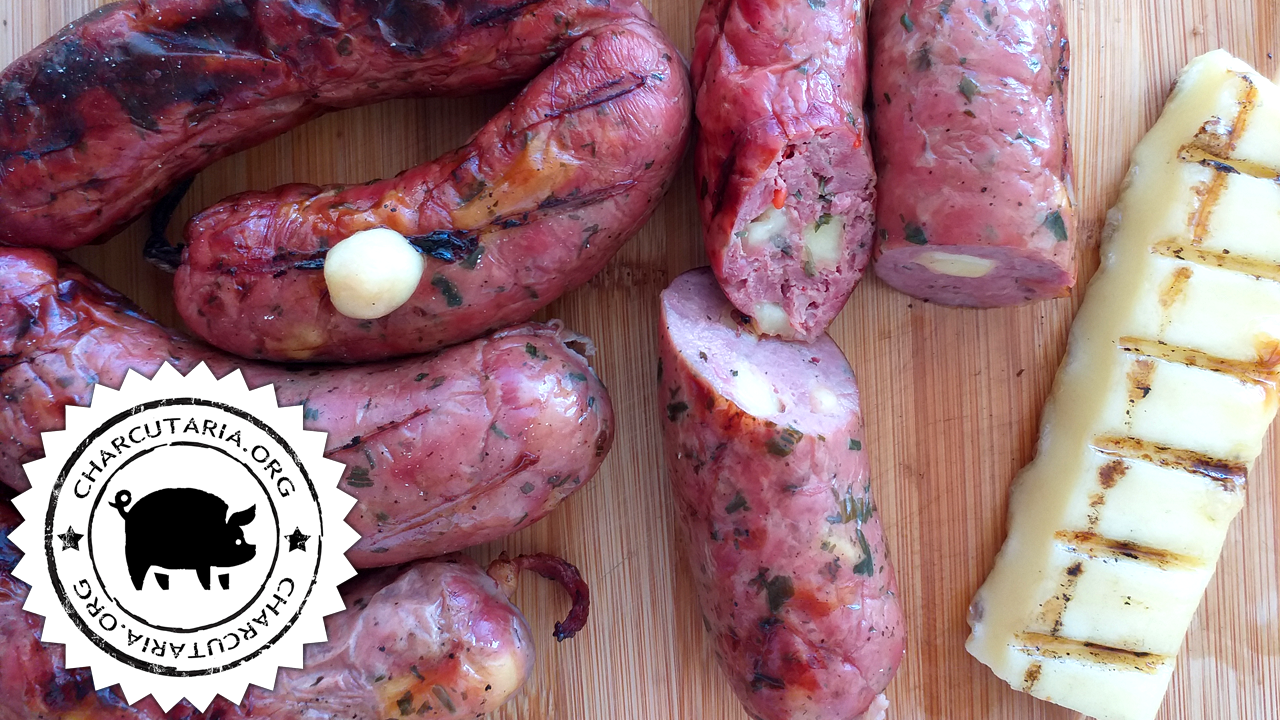
A coloração dos embutidos é um dos parâmetros de qualidade que mais influenciam na escolha do consumidor. A fabricação de linguiças (frescais ou cozidas) envolve a adição de alguns aditivos, que, apesar de terem funções tecnológicas diferentes, causam um efeito na coloração do embutido. Dentre eles, temos:
Nitrito
Geralmente comercializado como sal de cura. Utilizado principalmente como conservantes em produtos cárneos curados juntamente com os nitratos. Nas linguiças cozidas, são utilizados para obter a coloração rosada característica deste alimento, uma vez que em condições favoráveis a partir do nitrito (NO2) se origina o óxido nítrico (NO), componente ativo que se combina com a mioglobina (Mb) do músculo para formar nitrosilmioglobina (NOMb), a qual se transforma em nitrosilhemocromo ou nitrosoferrohemocromo, e fixam a coloração avermelhada da carne.
Ácido ascórbico
É um composto orgânico que serve como antioxidante, sendo obtido de forma natural por extração de vegetais ou de forma sintética por fermentação microbiana. Também tem a capacidade de diminuir o nitrito residual diretamente em óxido nítrico e, portanto, ajuda a manter o produto sob o limite legal de nitrito permitido;
Ascorbatos
São antioxidantes que derivam do ácido ascórbico. São utilizados para intensificar e acelerar o desenvolvimento da coloração de cura em linguiças cozidas. Os mais empregados são ascorbato de sódio (INS 301), ascorbato de cálcio (INS 302) e ascorbato de potássio (INS 303) [INS = International Numbering System for Food Additives; os números INS foram elaborados pelo Comitê do Codex sobre Aditivos Alimentares e Contaminantes para estabelecer um sistema numérico de identificação em âmbito internacional];
Ácido eritórbico
É um esteroisômero do ácido ascórbico. É utilizado como antioxidante e tem como função, na elaboração de linguiças cozidas, potencializar a coloração rosada característica. É identificado como INS 315, e o eritorbato de sódio (INS 316) também pode ser empregado na produção desse tipo de alimento;
Ácido cítrico
É um acidulante utilizado como potencializador da coloração das linguiças cozidas. É obtido de forma natural, pela extração de frutas cítricas ou sinteticamente, por meio da fermentação do fungo Aspergillus niger. Seu número INS é 330. Sua adição deve ser realizada no final do processamento com o intuito de manter a massa em níveis ideais de pH o máximo de tempo possível.
A coloração das linguiças também pode ser obtida com a incorporação de aditivos que têm como função transmitir essa característica sensorial (corante). Para isso, podem ser utilizadas substâncias obtidas de fontes naturais ou preparadas por métodos físicos e químicos, tais como:
Ácido carmínico
É considerado um ácido orto-fenoxi-carboxílico de caráter hidrofílico, o qual apresenta uma coloração avermelhada, que pode variar até púrpura, quando o pH aumenta. INS 120 é extraído da cochonilha (Dactylopius coccus), sendo utilizado como corante em linguiças cozidas para compensar a falta de mioglobina. É estável na luz e no calor e sob variações de pH;
Betanina
É um corante natural conhecido como INS 162, betacianina ou vermelho beterraba, visto que deriva do extrato deste tubérculo. É considerado um aditivo inócuo que é ocasionalmente utilizado na fabricação de linguiças cozidas porque possui pouca estabilidade diante da luz e do calor;
Extrato de páprica
O INS 160c. É um extrato obtido do pimentão vermelho que é amplamente utilizado na elaboração de linguiças frescais. No entanto, na produção de linguiças cozidas sua utilização é limitada, uma vez que, dependendo da quantidade adicionada, há a possibilidade de geração de tonalidades amareladas ou alaranjadas no produto final.
É importante ressaltar que os corantes devem ser adicionados à massa no começo do processo, para garantir uma distribuição uniforme. Hoje, a adição de pigmentos vegetais e/ou compostos naturais na elaboração de linguiças é uma alternativa para diminuir a utilização de nitritos e outros aditivos que transmitem a coloração deste embutido ou a potencializam.




Posso utilizar o corante ins 124 em linguiça caseira ?
Para consumo próprio, sim. Para comercializar não, pois são permitidos apenas os corantes naturais, como o carmim e o beterraba.
Bom dia, qual a recomendação do uso de corante por kg de carne ??
Cada corante tem uma concentração de pigmento, precisa consultar as especificações e recomendações do corante que tiver adquirido. Mas geralmente é bem pouco que usa, só para aumentar um pouco o tom.
Onde eu posso encontrar produtos que não possuam o corante carmin de cochonilha (INS 120)?
Embutidos comerciais com corantes sempre usarão o cochonilha. Há outros corantes, mais utilizados em confeitaria, que não possuem o cochonilha, como este: https://charcutaria.org/produto/corante-vermelho-alimentar/
Bom dia!
Faço umas Coppas Lombo em casa me servindo de uma receita do site.
Elas são bastante apreciadas por quem come.
No entanto pergunto:
para que fiquem com aquela coloração avermelhada, bonita,
= que aditivo posso utilizar?
Obrigado pela orientação.
Luiz Carlos
Luiz Carlos, geralmente só o sal de cura e uma bom tempo de maturação já são suficientes para deixar a coloração bem vermelha. Qual das receitas do site tem utilizado? Posso analisar e dar alguma sugestão de alteração para aumentar a coloração.
Boa tarde! Gostaria de saber como colocar a cor Vermelha da das linguiças frescas tipo Linguiça Mineira, compradas nas lojas no RJ.
Sal de cura ou corante vermelho, ambos são ingredientes comuns em linguiças que deixar a cor vermelha.
Boa noite gostaria de saber qual é a cantidade de paprica que eu posso usar em 10 quilos de carne de porco para linguiça cazeira
João, pode colocar 5g por kg, ou seja, 50 gramas de páprica em 10 kg de linguiças. Se for páprica picante coloque a metade disso para não apimentar demais a linguiça.
boa noite, gostaria de saber quantos kg de fécula de mandioca posso colocar por cada 💯 kgs de Massa de carne de porco ou mesmo a linguiça mista: dês de já obrigada e fica com Deus 🙏🏻
Depende muito do produto que deseja fazer, como regra geral recomendo que acrescente por volta de 2% sobre o peso da massa cárnea(20g de fécula por kg). Faça testes em pequena escala até obter o resultado desejado.